Sat 19 Apr 2014
A Movie Review by Jonathan Lewis: INNER SANCTUM (1948).
Posted by Steve under Mystery movies , Reviews[9] Comments
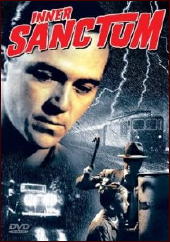
INNER SANCTUM. Film Classics, 1948. Charles Russell, Mary Beth Hughes, Dale Belding, Billy House, Fritz Leiber, Nana Bryant, Lee Patrick, Roscoe Ates. Director: Lew Landers.
I placed the DVD in the player, turned off the lights, grabbed some popcorn, and sat down to watch the Lew Landers-directed Inner Sanctum on an atypically cold spring New England night.
While it is certainly not one of the best-known films noir, Inner Sanctum has many of the genre’s elements: black & white cinematography with ample shadows, a murder, jealousy and betrayal, a woman (or two) scorned, a man at his breaking point, and a suspenseful plot with a clever, twist ending.
We begin with grainy footage of a train. On board sits a mysterious white-haired gentleman — an apparent clairvoyant psychic with a notable disdain for watches — who tells the woman seated next to him a cautionary tale about a woman who refused to heed a warning not to detrain.
The man, we learn, is named Dr. Valonius, although he is not a medical doctor. Portrayed by Fritz Leiber, Sr., father of the accomplished fantasy-science fiction author of the same name, Dr. Valonius overall remains dispassionately calm when telling Eve Miller (Marie Kembar) the story of a headstrong woman who after, disregarding a warning, got off a train when she shouldn’t have and got killed.
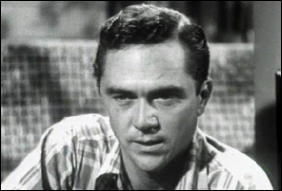
The heart of Dr. Valonius’s story, and of the film’s narrative, is about the dark psychological journey of her murderer. But with Inner Sanctum running at a mere 62 minutes in length, we never learn all that much Harold Dunlap (Charles Russell), except that he seems to be willing, for most of the movie at least, to do just about anything to not get caught.
As it turns out, however, Dunlap wasn’t totally alone on the train platform when he murders the woman. There was a witness to his chilling act. Sitting there, just watching trains, was a young boy, Mike Bennett (Dale Belding). While not a witness to the crime itself, Mike encounters Dunlap after the deed is done and notices blood on Dunlap’s suit jacket. It’s dark out, though, so maybe the kid isn’t seeing everything all that well.
The story follows the film’s anti-hero, Dunlap, as he maneuvers his way both physically and psychologically through the small Pacific Northwest town where he finds himself. Problem is, the town is experiencing extreme flooding and Dunlap can’t get out. He’s trapped.
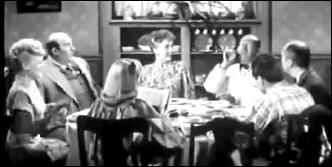
After hitching a ride from a jocular overweight man named McFee (Billy House), Dunlap ends up staying at a boarding house. It’s filled with archetypical characters right out of central casting. Among them, a single mother who desperately wants a husband, a San Francisco beauty with a hidden past and a thing for dangerous men (Jean Maxwell portrayed by Mary Beth Hughes, best known for her role in the 1943 western, The Ox-Bow Incident), a drunk who likes his beer, and a precocious young boy—the same kid a blood-encrusted Dunlap encountered at the train station.
Dunlap’s relationships with Maxwell and with young Mike Bennett make up the central part of the film. Although he’s not guilt-ridden, he still has to make some choices to make. Is he going to run away with Maxwell or not? Is his secret worth killing over, even if it means killing Mike?
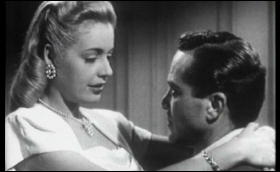
The film touches upon some quasi-philosophical questions, such as what does it mean for a good man to go bad, but hardly considers them in any meaningful depth. In many ways, there is very little redeemable about Dunlap. He’s definitely noir, rather than a shade of grey.
Part of this may have to do with Russell, who was less known as a film actor and better known as a radio actor, notably in CBS’s Yours Truly, Johnny Dollar. He portrays Dunlap as a paranoid, angry man. Indeed, in some spine chilling moments, he really does look crazed. But there’s not much range of emotion. Russell’s acts like angry and embittered man throughout the course of the film, making his performance, in a way, boring.
Dialogue in the film ranges from hackneyed to comedic and everything in between. The first time Dunlap tells Maxwell, “You’re very pretty when you’re lips aren’t moving†it’s both dark and comedic. The second time he says it, it’s laughable (and not in a good way).
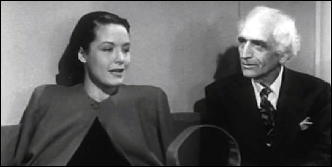
But there are some absolute gems as well, such as when Dr. Valonius tells the woman on the train why he doesn’t wear watches: “I have no need for such contrivances†and “I once had a difference of opinion with a watchmaker. I’ve boycotted timepieces ever since.†Such brilliant weirdness!
Inner Sanctum is in no way a big budget film or a must see. It’s sort of like a parlor trick. It’s fun and you kind of want to know how the director pulls it off. But the acting isn’t particularly memorable and, apart from the train, the settings are generally forgettable.
But then, there’s Dr. Valonius. Even though he’s in the movie for less than five minutes in total, Leiber definitely steals the show. And even though most films noir don’t deal with supernatural themes, there’s something about an old psychic on a train that’s about as noir as noir can get.
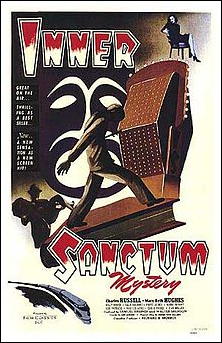
April 19th, 2014 at 12:36 pm
There are some pretty good people in this picture. Lee Patrick. Roscoe Ates. And, I have always been a sucker for Mary Beth Hughes. Well, maybe sucker isn’t the right word. She was wonderful.
April 19th, 2014 at 6:06 pm
Can’t mention Inner Sanctum without the creaking door and the radio series that inspired this. Though it was never equal to Suspense or its sister series Escape, it was a popular and atmospheric anthology and that famous creaking door is still recognizable today.
I always wondered why Hughes didn’t have a better career.
Leiber Sr. is in quite a few major films especially at Warner Brothers where he is the magistrate who condemns Peter Blood to slavery in Captain Blood. He’s a perfect presence for Inner Sanctum.
April 21st, 2014 at 3:23 am
The radio show must have been good indeed to have survived those dreadful Universal films, and as recall the name “Inner Sanctum” was slapped on a few what they call Erotic Thrillers in more recent years.
April 21st, 2014 at 2:29 pm
The “squeaking door” sound effect may have been the most famous of them all on Old Time Radio, even more than Fibber McGee’s closet.
April 21st, 2014 at 4:41 pm
One of the Chaney Universal entries is worth catching, Weird Woman as it is based on Fritz Leiber’s Conjure Wife, though overall I lean toward Dan’s characterization of the series.
April 21st, 2014 at 5:21 pm
Lew Landers is a director quite a few film historians today like, and want to investigate further. I’ve only seen a fraction of his huge output.
Some notes on his work:
http://mikegrost.com/landers.htm
April 21st, 2014 at 6:24 pm
Thanks for the link, Mike!
April 22nd, 2014 at 3:36 am
Landers did two of Lugosi’s most effective films: THE RAVEN (’35) and RETURN OF THE VAMPIRE
June 2nd, 2023 at 1:18 am
Do you know what Jean called McPhee at the breakfast table after he says “hello sweetheart”? It sounds like she says whisperer but the caption said Westbrook. Hope someone knows. He told her “Don’t call me that”.